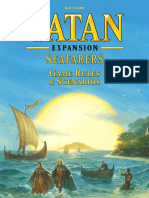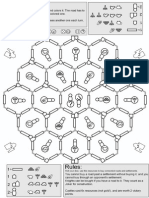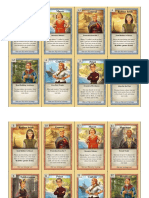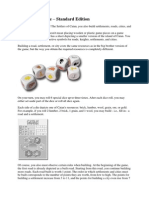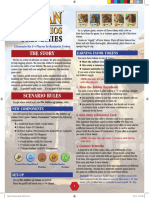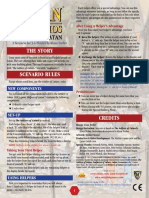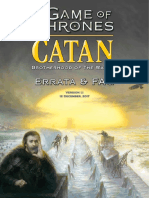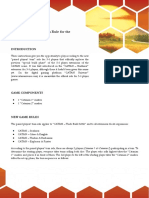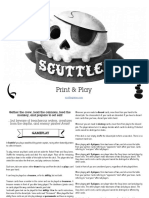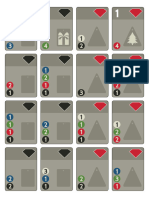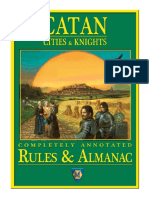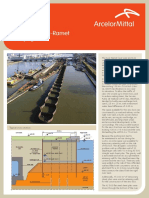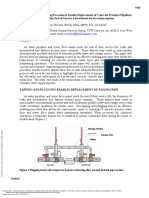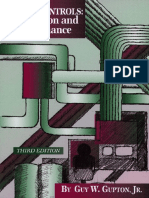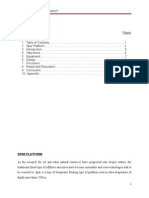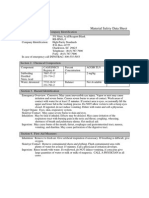Super Catan Rules
Super Catan Rules
Uploaded by
pmerta11Copyright:
Available Formats
Super Catan Rules
Super Catan Rules
Uploaded by
pmerta11Original Description:
Original Title
Copyright
Available Formats
Share this document
Did you find this document useful?
Is this content inappropriate?
Copyright:
Available Formats
Super Catan Rules
Super Catan Rules
Uploaded by
pmerta11Copyright:
Available Formats
Super Catan
Settlers with all three big expansions
Introduction:
When I frst acquired my copy of Settlers, I was excited. The components looked beautiful and the mechanics interesting. I couldnt wait to
get into my frst game. Unfortunately, the game was frustrating, luck-heavy, and tedious. I picked up the Seafarers expansion but it didnt
help. The scenarios and ships were neat additions but the mechanics that made me dislike Settlers were not improved upon. So Settlers was
condemned to the back of the closet, where it would sit for months...
Later on I learned about the Cities & Knights expansion. It looked exciting. Many of the problems I had with the base game were
changed or removed, and the extra tactical variety was quite alluring. I picked it up as fast as I could and was at once impressed with its
performance. Soon after I developed the Catan: Seasons deck which functioned as a new Event Deck that was compatible with Cities and
Knights, fnally fxing the last problem I had with Catan (the dice). A few months down the road, Traders & Barbarians was announced,
and I also excitedly ordered it, fguring that at worst it couldnt ruin my already perfected Catan experience. I was happily proven right:
T&B, being a collection of small expansions, integrated seamlessly into my already colossal Catan game. Only a couple components didnt
appear to work, but they are not the focus of this document. Finally I had a game that shared the basic mechanics and themes of the
original Settlers of Catan, but was notably distinct from the vanilla version that I found so distasteful. Indeed, this new game has even
earned a name of its own, so that it can lure in detractors who had the same issues with the base game that I did: the game became known
as Super Catan!
Following are the complete rule changes and setup procedures required to play Super Catan as I have envisioned and refned it. The Traders
& Barbarians expansion is not required; nor is the Seasons deck (the offcial Event Deck works fne), but both are recommended. This
variant was constructed around the 4th Edition Settlers game, with all 56 Player extensions, but 3rd edition should do just as well. The
sea-frame pieces are likewise recommended, for those who dont have them.
Key:
Throughout this guide I make references to components and mechanics unique to the three big-box expansions. If you do not own all
three big-box expansions or you need to know in which book to look for a certain mechanic or concept, you can use the following color
coding guide to help you:
Components from Seafarers will be colored in blue. Note that you will need the Seafarers expansion to play Super Catan.
Components from Cities & Knights will be colored in green. C&K is not necessarily required, but is highly recommended.
Components from Traders & Barbarians will be colored in purple. Note that since Traders & Barbarians is comprised of many previously
released small expansions, you may not necessarily need T&B to use many of the T&B rules. However, so far as I know, T&B improves
upon many of these smaller expansions (specifcally The Great River) and is therefore recommended.
Setting up the island:
1. Preparing special production tokens
One of Super Catans strongest features is its fully randomized island setup. However, placing harbors and fshing grounds randomly
can prove to be tricky. The frst thing you need to do to prepare for play is to print out and use a replacement set of production numbers
(included on the next page). Alternately, you could just use the offcial production numbers, and mark one of each number (212) with a
small picture of a boat, or the word harbor, and then mark one of each number except 6 and 8 (25 and 912) with a picture of a fsh, or
the word fsh. Not all of these special tokens may necessarily be used in any given game, but that is a consequence of the random setup.
All production number tokens should be blank on one side.
2. Assemble the sea frame
The next step in setting up the random island is to assemble the sea frames, based on the number of players involved in the game, and
then place the rivers and castle tiles as shown in the following diagrams.
Frame size and River/Castle placement
Below are the placement of the sea frames based on the number of players in the game.
Also shown are the starting positions of the three rivers and the castle tile. The castles orientation can be random, but when
using more than one castle (56p), they must both share the same orientation.
River 2 River 3 River 1
2 players
3 players
4 players
5 players
6 players
R
i
v
e
r
1
R
i
v
e
r
1
R
i
v
e
r
1
R
i
v
e
r
1
R
i
v
e
r
1
R
i
v
e
r
2 R
i
v
e
r
2
R
i
v
e
r
2 R
i
v
e
r
2
R
i
v
e
r
3
R
i
v
e
r
3
Castle
Castle
Castle
Castle
Castle
Castle
Castle
Note: if you do not have the River or
Castle tiles, just set up the sea frames
as shown and go to the next page.
4. Production numbers
After youve drawn and placed all the hex tiles, its time to place the production numbers. Randomly draw and place a production number
on each non-sea hex, ensuring that no two red numbers are adjacent, as per normal rules. However, in Super Catan, the swamps at the
mouths of the rivers count as Gold Fields, and should receive a production number! Additionally, the desert hex gets two numbers (as long
as theyre both different and arent both red) that are used to activate the camel pieces. Note that the castle does not get a number.
5. The Lake(s)
After youve set up the numbers, its time to set up the lake (T&B expansion). First you check to see if theres any sea hex thats completely
surrounded by land hexes, and at least one of those land hexes has a production number with a red fsh. If so, then you replace the sea hex
with the Lake hex. If multiple surrounded sea hexes tie for a lake hex, the lake goes in the one with the production number showing a fsh
that has the highest production number (12, 11, 10, 9, etc.). After you set the lake, turn the fsh-production number upside-down so that
you wont count it again for the fshing grounds (next step). If youre playing with 5 or 6 players, then you look around for a second fully
surrounded hex, turning that into a second lake (with the 5/6p lake tile), using the same tiebreaker method above if necessary. Note that
a fsh icon is required to place a Lake hex, so its possible that there may be no lake hexes in the game at all, if none of the fsh icons lie on
land hexes adjacent to a surrounded sea hex.
6. The fshing grounds
Then its time for the fshing grounds (also T&B). Look around for all the production tiles that have a red fsh on them that havent been
turned upside-down when placing the lake(s). Starting with the one with the highest production number, check to see if there are any
places bordering that hex where you can place a random fshing grounds tile. Its V shaped, so it has to border two land edges together
(this could either be two different land hexes, or the same hex twice). Note that a fshing grounds tile cannot physically overlap any other
fshing grounds tile! If there are multiple legal places to put it, randomly determine which place to put it. If there are no legal places to put
it, then one will not be placed. Then, fip the fsh production number face-down. Continue doing this until each fsh production number
has received a fshing ground, if able. When youre done, fip all the fsh production numbers face-up again, for use in the game.
If youre not using the River or Castle, the pool contains:
2p 3p 4p 5p 6p
Fields 3 4 5 6 8
Forests 3 4 5 7 8
Hills 3 4 6 7 8
Mountains 3 4 6 7 9
Pastures 3 4 6 8 9
Deserts 1 1 1 1 2
Gold Fields 1 2 3 4 6
Sea hexes 10 14 16 21 23
Setup, contd:
3. Placing random hexes
After youve set up the frames and the rivers and castles, you need to fll the empty hex spaces with normal game hexes. Make a pool of
facedown hex tiles, using a certain number of each type, based on the number of players. Listed below are two tables: one for if youre using
the Rivers and Castle; one if you arent. Of course, you could always relegate the drawing of tiles to be completely random from your entire
set, but the following numbers ensure that there is a more or less even spread of each terrain type.
Draw and place hex tiles from the pool and fx them face-up inside the sea frame until all the empty spaces within the frame have been
flled.
If youre using the River and Castle, the pool contains:
2p 3p 4p 5p 6p
Fields 3 4 5 6 7
Forests 3 4 5 6 7
Hills 2 2 3 4 6
Mountains 2 2 4 4 6
Pastures 3 3 5 5 6
Deserts 1 1 1 1 2
Gold Fields 0 0 1 2 4
Sea hexes 9 13 16 21 23
7. The harbors
Finally, its time to place random harbors. Harbors are placed similarly to fshing grounds (step 6). Look around for each production
number that shows a ship. Starting with the one with the highest production number, place a random harbor along one of the edges of
the hex, if there are any that border the ocean. Note that the harbor cannot physically overlap another harbor or a fshing ground, and
it cannot be placed inside a body of water thats fully surrounded by land (where the trade ships coming from?). A harbor also cannot
be placed at the exact mouth of a river (the delta is too swampy). If there are multiple possible places for the harbor that border the hex,
randomly choose where the harbor goes. If there are no legal spots (perhaps the harbor is land-locked or placing the harbor on any of the
water spaces would cause it to overlap another harbor or a fshing ground), the hex receives no harbor tile. Continue doing this until there
are no remaining ship-numbers to try and place a harbor.
Placing starting settlements and cities:
1. Place frst settlement
Select a player at random. Starting with that player and going counter-clockwise, each player places one settlement (and a road or a ship
as normal; but not a bridge) somewhere on the board. Note that settlements, cities, roads, and ships alongside the rivers still give gold
pieces to the players, even during setup.
2. Place frst city
After all players have placed a settlement, the players each place one of their cities somewhere on the board (with a road or ship), starting
with the last player to place his/her settlement and going clockwise. These cities obey the distance rule as normal.
3. Place second settlement
Finally, starting with the last player to place a city and going counter-clockwise again, each player places a second settlement somewhere on
the board (with a road or ship, and observing the distance rule, of course). The players collect goods based on where this second settlement
was placed, as in a normal game. This third starting spot is important to help players to make the biggest variety of goods as possible, to
prevent the game from having a slow and frustrating start.
Then the game begins, as normal. The player who was the last to place his/her second settlement is the frst player to take a turn, and
turns are taken in clockwise order for the rest of the game.
Rule changes for Super Catan:
This section highlights the changes made to the offcial Catan rules. Im going to assume that youre already familiar with all the
core rules of Settlers of Catan, and for those expansions that you do have, that you are familiar with their rules as well. The rules for Super
Catan are fundamentally the same as for regular Catan, with a few exceptions:
1. Victory condition
A player wins the game when, at any point during his/her turn, s/he has as many victory points as 17 minus the number of players (e.g. in a
3-player game, 14 victory points). Scaling the victory point requirement down with more players keeps the game from dragging on.
2. Harbormaster
The Harbormaster card is used, with no rules changes. However, with a random harbor setup, it is often diffcult to acquire.
3. Special Builder
In a 5- and 6-player game, there is no Special Builder phase. The Special Builder phase adds confusion to a turn, which then adds time.
If you wanted to protect your cards from the Robber so badly, you should have built a couple City Walls!
4. Gold Fields
Gold Fields (including the ones at the ends of the rivers) produce Gold pieces. During production, a settlement will produce one gold
piece, and a city will produce two. These are the same type of gold pieces that players gain when they settle along rivers and build bridges.
That is, they can be traded for goods (twice during a turn, a player can trade gold to the bank: 2 gold for a resource of their choice or 3
gold for a commoditysee Rule 5), and players will gain/lose points for having the most/least gold pieces via the Wealthiest/Poor Settler
cards. If you dont yet have the Traders & Barbarians expansion, you can use the seafarers Catan chits to represent gold pieces, as they are
not needed for anything else.
Rule changes, contd:
5. Poorest Settler
If all players are tied for poorest settler (fewest gold pieces), nobody gets a Poor Settler 2 VP card.
6. Gold Pieces for Commodities
Gold pieces may not be stolen from players, as usual, and they dont count towards a hand size, as usual. Also, as usual, players may trade
gold between each other or to (or from) the bank as though they were resources, or may twice per turn trade to the bank at a 2-to-1 rate
without any harbors. However, instead of trading 2 gold pieces for one resource of their choice in this manner, the player may instead
trade 3 gold pieces for one commodity of their choice. Both trades may be for commodities. In addition, the Merchant token may be placed
on a Gold Field, giving the player unlimited 2-to-1 trades for resources or commodities on his/her turn.
7. Barbarian Attack
The placement of barbarian pieces occurs differently: if the event die result for the turn shows the barbarian ship, then immediately
after advancing the barbarian ship forward (and resolving an attack, if there is one), the player whose turn it is must place (if able) one
barbarian token onto the board. The barbarian token is placed on any non-conquered hex that borders the ocean (the ocean is defned as a
body of water that touches the outside sea frame pieces: landlocked water tiles or the lake dont count) and that shows the rolled production
number from the turn. Of course, if this results in three barbarians being on one hex, that hex becomes conquered (T&B rules) and will
not produce resources this turn. One or two barbarians on a hex dont do anything, as normal.
8. Development Deck
Instead of the base games development deck, the players buy cards from the Barbarian Attack development deck (same cost: one grain,
wool, ore). The card takes effect immediately and is discarded to the bottom of the development deck, as normal.
9. C&K Knights and banishing bararians
The rules for removing barbarians by using the T&B horseback knights (only obtained via the development deck) work as normal.
However, the circular knight tokens from Cities & Knights can be used to banish barbarians from the island. During a players turn, the
player selects a hex with barbarians on it. He deactivates any number of his active knights that are adjacent to that hex. He then removes a
number of barbarians from that hex equal to the total power of the deactivated knights, minus 1. Thus, if a player deactivates a level-
1 and a level-2 knight on the same hex at the same time, he can remove (2+1)-1= two barbarians from that hex. Clearly, a level-1 knight
working alone can do nothing about barbarians. Those barbarians are not taken prisoner by the player; instead they are returned to the
supply. C&K knight tokens and T&B horseback knights cannot work together; C&K knights only remove barbarians from the board, and
T&B horseback knights only take barbarians prisoner at the end of a players turn. Ejecting barbarians from a conquered hex, of course,
renders that hex un-conquered again.
10. The Caravan Camels
The rules for adding camels is different. Rather than using the oasis tile, camels emerge from a regular desert tile. Camels emerge following
these rules: after resolving the event die, but before players take their resources, if either of the numbers in the desert were rolled, a camel
voting round begins. Starting with the player whose turn it is and going clockwise, each player may vote once on where a camel will be
placed, by spending any number of wool and/or grain (even zero), counting each card as one vote. Using their wagon pieces, players mark
where the new camel will be placed. Multiple players voting on the same placement pool their votes together. After each vote is placed,
the direction with the most votes receives a new camel on the indicated space. If there is a tie for most votes (even zero), the player whose
turn it is decides. A camel may be added to an existing camel train, or a new one may emerge outward from any of the vertexes along the
desert hex (if able). As per normal rules, camel trains may not branch out, but multiple camel trains may merge together. The scoring for
camels is the same as normal: each camel alongside a road (or bridge or ship) counts the length of that road as 2 instead of 1, for purposes
of taking the Longest Trade Route card. Each camel train that passes through a city or settlement makes that city or settlement worth 1
additional point than normal. If a city or settlement is alongside the desert, the rule is the same: if the frst camel in a train passes through
the settlement or city, it is worth one more point. Note that in the unlikely event that a desert is completely surrounded by water, it will
not be possible to produce a camel train (camel trains must emerge straight out of a desert; they cannot begin along the edge of the desert).
If multiple deserts have their production number rolled, both will be voted onbut the player whose turn it is decides which deserts
voting gets resolved frst.
11. Bartering fsh
In addition to the regular purchases a player can make with fsh during his/her turn, s/he can additionally buy these:
(2 fsh): one of the T&B horseback knights may move 5 spaces instead of 3 (this is the same as feeding one a grain card).
(6 fsh): build one bridge for free (and gain the three gold pieces as normal).
Summary of a turn:
Following is the summary of the steps of a turn, including all the Super Catan mechanics:
1. Roll the three production dice (or draw the Event/Seasons card).
a. Resolve the event on the Event/Seasons card.
b. Resolve the event die, possibly resulting in a barbarian attack which would be resolved now.
c. If the event die showed a barbarian ship: add a barbarian to a coastal hex of the same production number that was rolled.
d. If one of the deserts production numbers was rolled, perform a camel voting round. If multiple deserts should receive a
voting round this turn, the player whose turn it is decides what order to resolve them.
e. Players produce goods (resources, commodities, gold pieces and fsh).
2. Building and trading phase (as normal). Players can also activate C&K knights or perform actions, including removing
barbarians from adjacent hexes.
3. Move horseback T&B knights: each may move 3 spaces for free, or 5 spaces if a grain or two fsh is spent. Horseback
knights may move onto ships, but only ships that are the same color as the knight (owned by the same player). Horseback knights
may move onto any space that borders at least one land hex, without restriction. They may not end movement on the Castle hex.
4. Resolve any battles between the horseback knights and the barbarians. Take the barbarians prisoner and
roll to see which knights (if any) are removed from the board (remember to award compensation gold for lost knights!).
5. The next player clockwise takes his/her turn. Continue until a player is declared winner!
Have fun and enjoy!
Tibs (tibs.chris@gmail.com)
May 2010
Catan: The Seasons variant:
The Event Deck included in the Traders & Barbarians expansion is a satisfactory substitution for rolling the two numbered dice. However,
I have designed a 76-card revision of this deck, called Catan: The Seasons. This new deck is designed both to simulate all three dice
(including the event die), and to interact with more of the elements of the Cities & Knights expansion. This variant does not need to be
played with Super Catan and can be played with any regular Catan game.
As the game plays out, the weeks roll by and eventually the seasons change. Clear skies can turn to thunderstorms or blizzards in an
instant. During some seaons, scientifc advancement and trade are favored slightly. At other times, politics takes a small lead. Even the
barbarians are wary of the change in the seaons, and double back when the weather is not in their favor!
You can download Catan: The Seasons at http://boardgamegeek.com/flepage/39253/catan-seasons
Surplus
Spring
Summer
Winter
Autumn
Each player may discard one resource or
commodity to receive one resource of his/her
choice. You may not take a commodity.
8
Anniversary
Rcmovc this card and thc thrcc cards titlcd,
Thc Nct 8cason Bcgins!
8hufuc thc rcmaining cards.
Dcal four faccdon stacks of 13 cards. Placc thc
Nct 8cason cards faccdon undcrncath thrcc
of thc stacks, and placc this card faccdon undcr
thc fourth.
8tack thc four pilcs into onc dcck so that this card
is on thc vcry bottom. Placc thc rcmaining 20
cards faccdon undcrncath thc dcck.
Thcn advancc thc scason markcr forard onc
spacc, and dra a nc card.
Spring
Summer
Winter
Autumn
Catan: Thc 8casons
Intro:
I nrst started piaying Catan with the Ivent Deck. It was denniteiy nice restricting the die outcomes to their proper distribution. But the deck had its naws. Some
card events were vague at best, and it became possibie to count cards to an extent. It was aiso dincuit to track whose turn it was, since nobody had the dice sitting
in ront o them.
When I bought the immenseiy great citi.s koi/ts expansion, the game became much, much better. But the Ivent Deck had to go-it was annoying roiiing one die
and nipping a card. CsK added enough compiexity as it was, so I thought, the dice wiii stick to their own distribution curve. Boy was I wrong. Weird things kept
happening. tons o 8s in a game but no 6s more 12s than 5s Piease. A coupie o my piayers kept insisting we go back to using the cards. So I created an aiternative
that not oniy does the job, but side-steps the issues with the originai Ivent Deck. Im pieased to bring you. Catan: Thc 8casons:
8ctup:
Print and cut out the 6 cards, including the one in the center o this sheet. Ive inciuded sheets with backsides or the cards too, or those who can print doubie-sided.
1his deck is intended to be used with the Cities s Knights expansion. I youre not using CsK, I highiy recommend using the reguiar Catan Ivent deck.
Iach card is supposed to represent a week, so 52 cards wiii represent a year. Set aside the Anniversary and the three 1he Next Season Begins cards, and shune the
remaining 2. Set aside 20 cards and deai the remaining 52 into our ace-down piies o 1~ cards each. 1hese our piies wiii act as the our seasons. Piace the three
Next Season Begins cards underneath three o the decks and stack them. Piace the three stacked decks onto the ourth, put the Anniversary card underneath this
our-season stack, and then put the 20 aside cards underneath the whoie thing. \ou shouid now have one ace-down deck.
1~ cards, then a Next Season, 1~ cards, then a Next Season, 1~ cards, then a Next Season, 1~ cards, then Anniversary, 20 cards that wont be used this year.
Ater aii the piayers have piaced their starting settiements and received their starting goods, piace a marker (randomiy) on one o the our season squares.
Basic Rulcs:
1he piayers no ionger roii the dice. At the start o a piayers
turn, the piayer reveais the top card o the Seasons deck
and resoives it, in this order.
1) 1he piayer reads the name
o the card (i any), and then
reads the action printed
beiow the picture. 1hen the
piayer(s) perorm the action, as
appropriate.
2) Ater the event is resoived, the
piayer deciares the resuit o the
Ivent Die, based on the season
the piayers are currentiy in.
In this exampie, i the current season was Autumn or
Summer, the Ivent Die wouid show a Barbarian Ship,
and the Ship wouid advance a space on its track. I the
season was Winter or Spring, the Ivent Die wouid show
the corresponding coiored castie, aiiowing certain piayers
to draw progress cards based on the Rcd Dic rcsult, as
per the ck ruies.
~) Iinaiiy, the piayer deciares which number produces
this turn. In this exampie, 8s produce. 1he Red Die is
oniy shown to determine which piayers, i any, receive
progress cards this round.
Alchcmist:
I a piayer wishes to use the A/./.oist progress card, he
must do so at the start o his turn, bcforc nipping the
top Season card.
When the piayer uses the Aichemist card, he sets the
numbers on the red and yeiiow dice, as per normai CsK
ruies. He then nips the top Season card, to determine the
speciai event and the resuit o the Ivent die, resoiving
the production number iast (and ignoring the red die and
production number on the card).
1he text on a k//. Atta./s or Ii/uayo.o card is
ignored, even i the piayer set the dice to (a normai
Robber attack wouid be perormed).
Wcathcr and Holiday:
1he I/iaay and V.at/. cards show events that are based
on the season. 1hese cards are resoived in the normai
order iike other cards, but dierent events wiii be printed
inside the season boxes.
In this exampie, i the season
was Autumn, there wouid be a
Harvest moon. Iach piayer may
immediateiy draw one grain i
they wish.
Since the Ivent Die or Autumn
shows the Barbarian Ship, the
Barbarian Ship wouid advance
one space (and the barbarian
attack wouid be resoived i there
was one), and then 8s wouid produce.
Thc Robbcr and thc Highaymcn:
1he deck contains six Robber Attacks cards. On these
cards, there is no speciai action. 1he Ivent Die wouid
be resoived nrst, and then the production number wouid
be resoived. Since the production number is a , the
reguiar Robber Attacks ruies wouid then be executed.
However, there are aiso six Highwaymen cards. 1hese
cards work exactiy iike the Robber Attacks cards,
except each o the Highwaymen cards aiters the normai
Robber Attacks ruies siightiy, sometimes they are iess
severe to certain piayers, sometimes more severe.
In this exampie, ater resoiving
the event die, the piayers perorm
the normai Robber Attacks
ruies. However, the robber may
not be piaced on a hex that is
occupied by the singie piayer
who has the ewest VPs.
I the robber was aiready on a
hex occupied by the piayer with
the ewest VPs, he wouid have
to be moved.
8
Weather
Flood
No orest hexes produce
iumber/paper this turn,
regardiess o the dice.
Spring
Drought
No neid hexes produce
grain this turn,
regardiess o the dice.
Summer
Cold 8pcll
Aii pasture hexes
produce wooi/cioth this
turn, regardiess o the
robber or dice.
Winter
Harvcst Moon
Iach piayer may
draw one grain.
Autumn
7
Spring
Summer
Winter
Autumn
Highwaymen!
No event occurs this round. After performing the
action on the event die, you perform the normal
Robber Attacks actions, but with this exception:
The robber may not be placed on a hex occupied by
the single player with the fewest VPs. If multiple
players tie for lowest, then this rule does not apply.
Thc 8cason 8quarc:
Cut out the square above, and use a token
to track the seasons.
Ater the piayers have piaced aii their
starting settiements, the starting season is
randomiy chosen.
Ater every 1~ cards, the season changes.
Ater 52 cards, the deck gets re-shuned
as per Set Up ruies, and the season wiii be
what it was when the game began.
Questions Comments
Imaii me at chriscrthibodcau.com
You might also like
- CatanDocument383 pagesCatanKristijan FedererNo ratings yet
- Amway Espring Product LeafletDocument6 pagesAmway Espring Product LeafletNutellaNo ratings yet
- War For Catan RulesDocument5 pagesWar For Catan Rulesapi-540416944No ratings yet
- Catan Rivals Hostel Scenario enDocument1 pageCatan Rivals Hostel Scenario enИван ИвановNo ratings yet
- Catan HelpersDocument3 pagesCatan Helperssergioslm33% (3)
- Settlers of Catan Strategy and Tactics GuideDocument14 pagesSettlers of Catan Strategy and Tactics GuidetsupasatNo ratings yet
- T S C - C A R & A (V 1.5) 1: HE Ettlers of Atan Ompletely Nnotated Ules Lmanac ErsionDocument30 pagesT S C - C A R & A (V 1.5) 1: HE Ettlers of Atan Ompletely Nnotated Ules Lmanac ErsionAngel Gallardo E.No ratings yet
- Ultra Catan Rules - Special Building PhaseDocument4 pagesUltra Catan Rules - Special Building Phasepmerta11No ratings yet
- Seafarers RV Rules 111105 PDFDocument32 pagesSeafarers RV Rules 111105 PDFCatalin SavinNo ratings yet
- Catan Dice Game XXL Variant in Black and White.v1Document1 pageCatan Dice Game XXL Variant in Black and White.v1risikosuperNo ratings yet
- Catan Helpers PDFDocument3 pagesCatan Helpers PDF1770313maryNo ratings yet
- 3D Catan Designed 3D Printed and PaintedDocument22 pages3D Catan Designed 3D Printed and PaintedTiago LealNo ratings yet
- Winterhaven Woods Rules 7.0 (Draft)Document25 pagesWinterhaven Woods Rules 7.0 (Draft)Eleonora StefaniniNo ratings yet
- Catan SeasonsDocument8 pagesCatan Seasonsjoe1lee_1No ratings yet
- CatanSettlersofAmerica RulesDocument16 pagesCatanSettlersofAmerica Rules1uis Fe11ipeNo ratings yet
- Catan Dice GameDocument2 pagesCatan Dice Gamegrifter28No ratings yet
- Traders and Barbarians 5 Ó 6 PDFDocument12 pagesTraders and Barbarians 5 Ó 6 PDFpipyirNo ratings yet
- Catan Dice Game ExtraDocument4 pagesCatan Dice Game ExtraAlfredo SanchezNo ratings yet
- Catan 5th Ed Rules Eng 150303Document16 pagesCatan 5th Ed Rules Eng 150303Eric100% (1)
- Catan Westayhome Scenario 200417Document1 pageCatan Westayhome Scenario 200417greengoxdNo ratings yet
- Catan-Scenario Easter Bunny PDFDocument2 pagesCatan-Scenario Easter Bunny PDFgreengoxdNo ratings yet
- Islet of CatanDocument2 pagesIslet of CatanRobert KornasNo ratings yet
- Settlers of Catan, Dice Game: Full Color Map With VariantsDocument4 pagesSettlers of Catan, Dice Game: Full Color Map With VariantsDr Jerzayn100% (1)
- Catan Frenemies Rules 093012sDocument2 pagesCatan Frenemies Rules 093012sArmelNo ratings yet
- Helpers of Catan Rules 130802sDocument2 pagesHelpers of Catan Rules 130802sAdrian ZorlescuNo ratings yet
- The Helpers of Catan (Rules)Document2 pagesThe Helpers of Catan (Rules)Frederic GuigandNo ratings yet
- Catan Catakatoa Instructions From Game Trade MagazineDocument1 pageCatan Catakatoa Instructions From Game Trade MagazineDaniel ArnoldNo ratings yet
- Agot-Catan Errata Faq 171214sDocument4 pagesAgot-Catan Errata Faq 171214sTopenkaNo ratings yet
- Catan Oilsprings ScenarioDocument6 pagesCatan Oilsprings ScenariobriantnguyenNo ratings yet
- Catan Family Edition Rules-053112sDocument4 pagesCatan Family Edition Rules-053112sJGCO100% (1)
- Best Treehouse EverDocument11 pagesBest Treehouse EverJimmy Lin100% (1)
- Wonders of CatanDocument3 pagesWonders of CatanHello ThereNo ratings yet
- Dice Game XXL RulesDocument3 pagesDice Game XXL RulesrisikosuperNo ratings yet
- Designed by Kenneth Stuart (Wizcreations) Designed by Kenneth Stuart (Wizcreations)Document1 pageDesigned by Kenneth Stuart (Wizcreations) Designed by Kenneth Stuart (Wizcreations)Facundo ParésNo ratings yet
- Setup (3 To 4 Players) : Important: You Are Not Allowed To Vote For Your Own Image!Document1 pageSetup (3 To 4 Players) : Important: You Are Not Allowed To Vote For Your Own Image!Hussein Hashemi SenejaniNo ratings yet
- Settlers of Catan Global WarmingDocument1 pageSettlers of Catan Global WarmingFiorella InderkumNo ratings yet
- BestTreehouseEver PNP v1-0 Optional-CardbacksDocument9 pagesBestTreehouseEver PNP v1-0 Optional-Cardbacksarkcaver100% (1)
- Catan Challenge SoloDocument4 pagesCatan Challenge SoloMadWelshWizardNo ratings yet
- Catan: The Paired Players' Turn Rule For The 5-6 Player ExtensionsDocument4 pagesCatan: The Paired Players' Turn Rule For The 5-6 Player ExtensionsBrian Jhesit Garcia100% (1)
- Seafarers of Catan Rules - OLDDocument33 pagesSeafarers of Catan Rules - OLDDaniel ArnoldNo ratings yet
- Trickster Supers PNP PreviewDocument7 pagesTrickster Supers PNP Previewмаксим гребенщиков100% (1)
- Rules Overview Splendor GamesDocument5 pagesRules Overview Splendor GamesIlayda DeveliNo ratings yet
- A Simple Life - v1.3.3 - RulebookDocument11 pagesA Simple Life - v1.3.3 - RulebookJesus BerberNo ratings yet
- Catan-Crop Trust Rulesalmanaceng 180705xsDocument12 pagesCatan-Crop Trust Rulesalmanaceng 180705xsjelleNo ratings yet
- Scuttle+Print+N+Play+ENGLISH+05 08 16Document10 pagesScuttle+Print+N+Play+ENGLISH+05 08 16desmontes100% (1)
- Catan - RulesDocument5 pagesCatan - RulesХуан БрухоNo ratings yet
- Print and Play!: The Super Cute DiyDocument14 pagesPrint and Play!: The Super Cute DiyImya FamiliyaNo ratings yet
- Recassonne - A Carcassonne VariantDocument4 pagesRecassonne - A Carcassonne Variantmatjaz_bevkNo ratings yet
- Citadels (Rules Summary)Document6 pagesCitadels (Rules Summary)oeikeebaNo ratings yet
- Rules Splendor USDocument4 pagesRules Splendor USfournies1754100% (1)
- Ace of Aces GameDocument6 pagesAce of Aces GameGreg JamesonNo ratings yet
- Laser Cut Board GamesDocument10 pagesLaser Cut Board Gamesmarius_danila8736No ratings yet
- Catan - Rambunctious Co-Opetition MapDocument4 pagesCatan - Rambunctious Co-Opetition MapAaron LozNo ratings yet
- Splendor TravelDocument14 pagesSplendor TravelCanal do TucanoNo ratings yet
- CitiesAnnotatedRules1 1 PDFDocument37 pagesCitiesAnnotatedRules1 1 PDFrangel.sardinhaNo ratings yet
- PDG Playbook FINALDocument72 pagesPDG Playbook FINALMaitre OliNo ratings yet
- Mighty Empires RulesDocument61 pagesMighty Empires RulesyifyguyNo ratings yet
- 696B398D FG EWP RiversRafts Rulebook-Min 2Document8 pages696B398D FG EWP RiversRafts Rulebook-Min 2David MillerNo ratings yet
- Catan - Treasures Dragons & Explorers English RulesDocument11 pagesCatan - Treasures Dragons & Explorers English RulesMartyn DalesNo ratings yet
- Small World - Randomly Generated Map VariantDocument12 pagesSmall World - Randomly Generated Map Variantjohncf1018No ratings yet
- Catan RulebookDocument4 pagesCatan RulebookSurvival Horror Downloads0% (1)
- Double Standpipe PiezometerDocument4 pagesDouble Standpipe PiezometerMehedi HasanNo ratings yet
- ArcelorMittal (2013) CS 018 - New Lock of Ivoz-Ramet, BelgiumDocument2 pagesArcelorMittal (2013) CS 018 - New Lock of Ivoz-Ramet, BelgiumBobNo ratings yet
- INF018 - Combined Cycle Gas Turbines - FINALDocument7 pagesINF018 - Combined Cycle Gas Turbines - FINALOwolobi OyephoNo ratings yet
- Impact of Rural-Urban Migration in BangladeshDocument33 pagesImpact of Rural-Urban Migration in BangladeshKhondker Rawan Hamid91% (11)
- SRHDocument2 pagesSRHTeree Sanches SaLazNo ratings yet
- RLE District 03 PDFDocument5,645 pagesRLE District 03 PDFTrevor BurnettNo ratings yet
- CH 4 Pump 2013.Document31 pagesCH 4 Pump 2013.hossamNo ratings yet
- The Structural Evolution of The Golden Lane, Tampico Embayment MexicoDocument36 pagesThe Structural Evolution of The Golden Lane, Tampico Embayment MexicoGustavo RebayNo ratings yet
- Rain Water Harvesting Seminar Report PDFDocument16 pagesRain Water Harvesting Seminar Report PDFHarveen Sai75% (8)
- Material Safety Data Sheet: 1 - Identification of Product and SupplierDocument3 pagesMaterial Safety Data Sheet: 1 - Identification of Product and SupplierChristianNo ratings yet
- Pipelines 2015 Recent Advances in Underground Pipe... - (Operations Maintenance Risk and Safety)Document259 pagesPipelines 2015 Recent Advances in Underground Pipe... - (Operations Maintenance Risk and Safety)Irina ElinaNo ratings yet
- Green Roof PDFDocument123 pagesGreen Roof PDFibrahimNo ratings yet
- Corrosion and Its ControlDocument23 pagesCorrosion and Its Controlapi-26041653No ratings yet
- Viessmann Vitodens 111Document112 pagesViessmann Vitodens 111cepanameabubuNo ratings yet
- Corfu Beaches - Corfu Nudist BeachesDocument6 pagesCorfu Beaches - Corfu Nudist Beachesdanut_doc0% (1)
- Unit 8 StsDocument4 pagesUnit 8 StsMaiikol Ortiiz100% (1)
- HVAC Controls Operation and Maintenance Third Edition by Guy W. Gupton, Jr.Document355 pagesHVAC Controls Operation and Maintenance Third Edition by Guy W. Gupton, Jr.eselco ingenieros100% (3)
- Water Purification and Wastewater TreatmentDocument32 pagesWater Purification and Wastewater Treatmentrishit_aNo ratings yet
- Ashrae Library 1 PDFDocument16 pagesAshrae Library 1 PDFosama alabsiNo ratings yet
- FT - 22 Upwelling and DownwellingDocument2 pagesFT - 22 Upwelling and DownwellingDr. Tapan Kr. DuttaNo ratings yet
- Spar PlatformDocument34 pagesSpar PlatformAmir HazimNo ratings yet
- GREASE, SAND + OIL INTERCEPTORS Inspection Checklist V 1.0 - 201511041303368641Document4 pagesGREASE, SAND + OIL INTERCEPTORS Inspection Checklist V 1.0 - 201511041303368641bradalbiNo ratings yet
- Aluminothermic MSDS T3.P - V02Document7 pagesAluminothermic MSDS T3.P - V02Tim WaskitakualatanjungNo ratings yet
- Checking The Machine +: Sorting and Loading LaundryDocument8 pagesChecking The Machine +: Sorting and Loading LaundryScribe78No ratings yet
- Bush Pump ManualDocument20 pagesBush Pump ManualStanislav SviderekNo ratings yet
- Solar Water Pump: Technology RoadmapDocument43 pagesSolar Water Pump: Technology RoadmapDeborah BryantNo ratings yet
- En Planner Reviewer: A. LDC & LFCDocument22 pagesEn Planner Reviewer: A. LDC & LFCAeron Paul AntonioNo ratings yet
- Section 1. Product and Company Identification: Material Safety Data SheetDocument4 pagesSection 1. Product and Company Identification: Material Safety Data SheetRiski ApriniNo ratings yet
- Vedanta Quarterly Checklist TemplateDocument4 pagesVedanta Quarterly Checklist TemplateYeetoNo ratings yet








